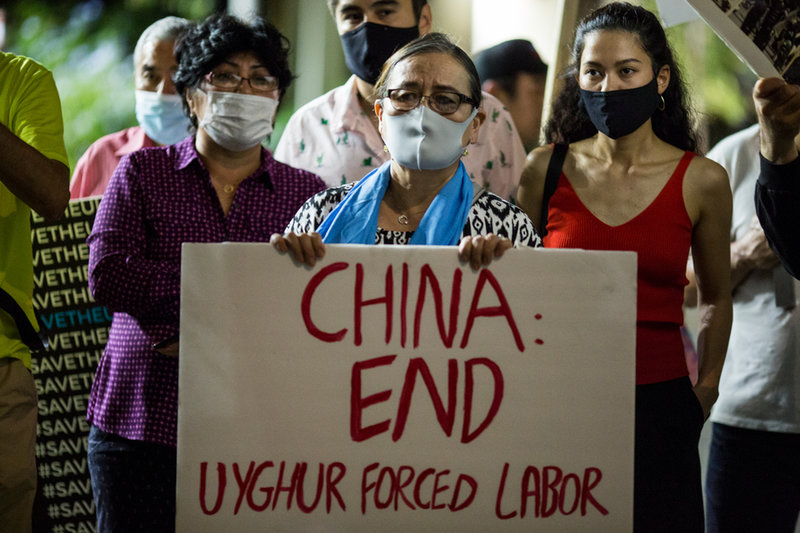Comment
Understanding the US’s legalised black market
The failure to fully enforce the Uyghur Forced Labor Prevention Act (UFLPA) and the de minimis loophole is devastating US textile and garment makers, writes National Council of Textile Organizations (NCTO) president and CEO Kimberly Glas.

One in five cotton garments in the global apparel market are made using forced labour from the Uyghur Region (as of 2020), according to Glas. Credit: Shutterstock.
What would you say if I told you that slavery is still alive and well in the global marketplace and products coming to your door may contain slave labour cotton? Worst of all, how would you feel knowing that while the US government is fully aware of this problem, it has failed to construct a comprehensive and aggressive enforcement programme to stop it?
In fact, the government is making it worse and rewarding those who don’t play by the rules, putting our businesses, workers, and people at risk. The lack of an effective enforcement programme combined with existing loopholes within our trading system has created the world’s greatest black market, serving as a gateway to facilitate forced labour products, dangerous goods, such as fentanyl, and counterfeit materials to our doorsteps.
The situation is serious and alarming and it’s time that this concern is communicated to the public. China’s Xinjiang Uyghur Autonomous Region (XUAR) has long been the site of atrocious human rights abuses and forced labour of the indigenous Uyghur population for the sake of low-cost goods such as clothing.
For the global textile market, the data speaks for itself:
- 20% of the world’s cotton is grown in Xinjiang and supplies China’s production, and it is also feedstock to other major countries throughout the world
- 72% of cotton products manufactured in China contain cotton produced in Xinjiang
- One in five cotton garments in the global apparel market are made using forced labour from the Uyghur Region (as of 2020)
- The human rights abuses associated with this genocide are impacting a population of an estimated 800,000 to 1.8 million Uyghur Muslims in the XUAR
- Since the passage of the Uyghur Forced Labor Prevent Act (UFLPA) in 2022, Xinjiang cotton production has increased, and the number of shipments being stopped and inspected by US Customs and Border Protection (CBP) has decreased. To put it in context, the United States imported $185bn of apparel, textile and footwear in 2022, yet CBP merely detained $35m of these products.
These are the main points I addressed at a hearing before the House Committee on Homeland Security’s Subcommittee on Oversight, Investigations, and Accountability recently.
So how did we get here?
Starting in the mid-1990s, China emerged as a large-scale predatory force benefiting from virtually limitless government programmes intended to ensure that China’s textile industry captured world markets and displaced foreign competitors and workers. Through a combination of economic factors and trade liberalisation policies, such as US congressional passage of legislation granting Permanent Normal Trade Relations (PNTR) with China in 2000 and China’s accession to the World Trade Organization (WTO) in 2001, the country cemented its dominance on the world stage and continued capitalising on its predatory trade practices.
From 1992-2016, Chinese textile and apparel exports to the world grew by a staggering 910%, skyrocketing from $26.4bn to $266.3bn. In fact, China’s share of the world’s textile and apparel trade quadrupled, growing from 9.5% in 1992 to 38.3% in 2016.
Astonishingly, now the United States government is rewarding this predatory behaviour through duty-free imports that put our US manufacturers and their workers out of work – through a little-known provision in US trade law called Section 321 de minimis waivers. These waivers allow duty-free importation of goods valued under $800 per day by a single entity into the US, the vast majority of which are uninspected. This provision was instituted over 100 years ago to allow travellers to bring back mementoes and not pay duty.
Today, in the ecommerce superhighway of ordering – this provision has exploded allowing three million de minimis shipments to come into the US everyday duty-free, effectively handing a free trade agreement to China and the rest of the world. What’s in the box and who makes it is unknown.
It’s a black box of little information and it’s facilitating tainted and dangerous products into our homes at the click of a button. It is through the exploitation of this loophole alone, that ecommerce distributors Shein and Temu, which have reportedly been linked to forced labour and lax environmental practices, have built empires virtually killing US manufacturing jobs overnight.
What does this mean for US consumers and the economy?
On a macro level, the failure to fully enforce UFLPA and reasonably regulate the US’s de minimis system is devastating to US manufacturers, like the US textile and apparel industry.
This crisis implicates us all in modern-day slavery and human rights abuses while exposing US citizens to low-quality, environmentally damaging products and highly dangerous narcotics, such as fentanyl. Without an effective enforcement plan, the use of forced labour is simply too widespread within global supply chains to stop. If CBP cannot tell you what is coming across the border, then Americans are at risk and the whole system needs to be shut down.
Consumers must be accountable for the products they buy. We can also demand the brands and companies we buy from take every conceivable step to extricate themselves from supply chains that are at risk of utilising slave labour.
Demanding that these products be made in the US, or at the very least, close to home in the Western Hemisphere would be a good start. In addition, we must call on our members of Congress to demand that our government take the actions necessary to stop these horrific human rights abuses. And while Congress works on a long-term solution, we must require the administration to shut it off immediately to protect all of us. When an issue of this magnitude confronts us, failure to act makes us complicit.
168,000t: Rare earths produced by Chinese mines in 2021.
Gavin John Lockyer, CEO of Arafura Resources

Caption. Credit:
However, Western mines are aiming to change this balance of production and power. The Mountain Pass Mine, owned by MP Materials , a Las Vegas-based mining company, is an open-pit mine of rare earths on the south flank of the Clark Mountain Range, 85km south-west of Las Vegas. In 2020, the mine supplied 15.8% of the world’s rare earth production and is the only rare earth mining and processing facility in the US.
In October 2020, Donald Trump, the former US president, signed an executive order declaring a national emergency in the mining industry, aimed at boosting the domestic production of rare earths. Trump ordered his cabinet to study the matter, with a view towards giving government grants for production equipment and imposing tariffs, quotas or other import restrictions against China.

Phillip Day. Credit: Scotgold Resources
The biggest rare earth mines are located in China, and this source of domestic production has helped drive Chinese dominance
Gavin John Lockyer, CEO of Arafura Resources

Caption. Credit: